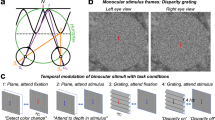Abstract
BINOCULAR neurons in the visual cortex are thought to perform the first stage of processing for the fine stereoscopic depth discrimination exhibited by animals with frontally located eyes. Because lateral separation of the eyes gives a slightly different view to each eye, there are small variations in position (disparities), mainly along the horizontal dimension, between corresponding features in the two retinal images. The visual system uses these disparities to gauge depth. We studied neurons in the cat's visual cortex to determine whether the visual system uses the anisotropy in the range of horizontal and vertical disparities. We report here that there is a corresponding anisotropy in the cortical representation of binocular information: receptive-field profiles for left and right eyes are matched for cells that are tuned to horizontal orientations of image contours. For neurons tuned to vertical orientations, left and right receptive fields are predominantly dissimilar. Therefore, a major modification is required of the conventional notion of disparity processing. The modified scheme allows a unified encoding of monocular form and binocular disparity information.
Similar content being viewed by others
References
Barlow, H. B., Blakemore, C. & Pettigrew, J. D. J. Physiol. 193, 327–342 (1967).
Poggio, G. F. & Fischer, B. J. Neurophysiol. 40, 1392–1405 (1977).
von der Heydt, R., Adorjani, C. S., Hanny, P. & Baumgartner, G. Expl Brain Res. 31, 523–545 (1978).
Ferster, D. J. Physiol. 311, 623–655 (1981).
Maske, R., Yamane, S. & Bishop, P. O. Vision Res. 24, 1921–1929 (1984).
Hubel, D. H. & Wiesel, T. N. J. Physiol. 160, 106–154 (1962).
Joshua, D. E. & Bishop, P. O. Expl Brain Res. 10, 389–416 (1970).
Hubel, D. H. & Wiesel, T. N. J. Physiol. 232, 29–30 (1973).
LeVay, S. & Voigt, T. Visual Neurosci. 1, 395–414 (1988).
Freeman, R. D. & Ohzawa, I. Vision Res. 30, 1661–1676 (1990).
Marr, D. & Poggio, T. Proc. R. Soc. B 204, 301–328 (1979).
Gabor, D. J. Inst. electr. Eng. 93, 429–457 (1946).
Sakitt, B. & Barlow, H. B. Biol. Cybern. 43, 97–108 (1982).
Freeman, R. D. & Robson, J. G. Expl Brain Res. 48, 296–300 (1982).
DeValois, R. L., Albrecht, D. G. & Thorell, L. G. Vision Res. 22, 545–559 (1982).
Jones, J. P. & Palmer, L. A. J. Neurophysiol. 58, 1187–1211 (1987).
Marcelja, S. J. opt. Soc. Am. 70, 1297–1300 (1980).
Daugman, J. G. J. opt. Soc. Am. 2, 1160–1169 (1985).
Jones, J. P. & Palmer, L. A. J. Neurophysiol. 58, 1233–1258 (1987).
Poggio, G. F., Gonzalez, F. & Krause, F. J. Neurosci. 8, 4531–4550 (1988).
Nomura, M., Matsumoto, G. & Fujiwara, S. Biol. Cybern. 63, 237–242 (1990).
Schor, C. M. & Wood, I. Vision Res. 23, 1649–1654 (1983).
Schor, C. M., Wood, I. C. & Ogawa, J. Vision Res. 24, 573–578 (1984).
Ohzawa, I., DeAngelis, G. C. & Freeman, R. D. Science 249, 1037–1041 (1990).
Ohzawa, I. & Freeman, R. D. J. Neurophysiol. 56, 221–242 (1986).
Author information
Authors and Affiliations
Rights and permissions
About this article
Cite this article
DeAngelis, G., Ohzawa, I. & Freeman, R. Depth is encoded in the visual cortex by a specialized receptive field structure. Nature 352, 156–159 (1991). https://doi.org/10.1038/352156a0
Received:
Accepted:
Issue Date:
DOI: https://doi.org/10.1038/352156a0
- Springer Nature Limited
This article is cited by
-
Neural tuning and representational geometry
Nature Reviews Neuroscience (2021)
-
The binocular neural mechanism: disparity coding schemes and population coding
Science China Information Sciences (2015)
-
Sublinear binocular integration preserves orientation selectivity in mouse visual cortex
Nature Communications (2013)
-
Sublinear integration underlies binocular processing in primary visual cortex
Nature Neuroscience (2013)
-
Binocular Energy Estimation Based on Properties of the Human Visual System
Cognitive Computation (2013)





